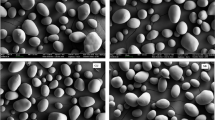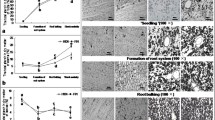Abstract
When cassava is harvested too early, it often leads to reduction in yield, while delayed harvest leads to development of woody and fibrous tuberous roots, and reduction in starch content. The optimum harvest time is not known. The objectives of this study were to determine the effect of genotype, location and season on starch extraction in order to find an optimum harvest regime for cassava, and to find the best parameter for monitoring starch levels in cassava tuberous roots. Results showed that genotypic effect was large for starch weight, starch extraction rate on fresh weight basis, and root dry matter content. This suggested that high starch weights could be realised by selection of suitable varieties for starch extraction. It was found that cassava harvesting and starch extractions should be done between October and November since the highest starch extraction rates were achieved during that period, and drying of the extracted starch using the open air method was fast and convenient. The results also suggested that starch levels can efficiently be monitored using starch extraction rate on fresh root weight basis. Starch content on fresh root basis and root dry matter content can also be used to determine the optimum time to harvest cassava for starch extraction but were inferior to starch extraction on fresh root weight basis.




Similar content being viewed by others
References
Agrobase (2000) Agrobase 20 for windows. Agromix Software, Inc., Winnipeg
Ashoka PV, Nair SV, Kurian TM (1984) Influence of stages of harvest on yield and quality of cassava, Manihot esculenta Crantz. Madras Agric J 71:447–449
Benesi IRM, Moyo CC, Mkumbira J, Chipungu FP, Mtukuso AP, Mahungu NM (2001) Cassava: becoming a giant crop in Malawi-Current status. In: Fauquet CM, Taylor NJ (eds) Cassava: an ancient crop for modern times. Proceedings of the fifth International Meeting of the CBN, held in November 4–9, 2001, St Louis Missouri, USA. CD2, CBN-V files-S1-02.pdf
Benesi IRM, Labuschagne MT, Dixon AGO, Mahungu NM (2004) Genotype × environment interaction effects on native cassava starch quality and potential for starch in the commercial sector. Afr Crop Sci J 12:205–216
Brautlecht CA (1953) Starch: its sources, production and uses. Reinhold Publishing Corporation, New York
Crossa J (1990) Statistical analyses of multilocation trials. Adv Agron 44:55–86
Danish EU-directorate (1996) Determination of starch content under water weight of 5050 g tuber. Instruction no. 2 Mkt. 4410-4-96 of July 1996 issued by Ministry of Agriculture and Fishery enforced on 1 July 1996 and revised on 31 December 1997. Available at http://www.starch.dk/isi/methods/13starch.htm
De Vries CA (1985) Optimum harvest time of cassava (Manihot esculenta Crantz). Abstr Trop Agric 10:9–14
Donnan Landscape Services (2005) Soil pH. Landscaping information and more, http://www.donnan.com/soilph.htm Cited 7 August 2006
Eckert D, Thomas Sims J (1995) Recommended soil pH and lime requirement tests. In: Thomas Sims J, Wolf A (eds) Recommended soil testing procedures for the north-eastern United States of America. North-East Reg Bull 93:11–16
Gee GW, Bauder JW (1986) Particle size analysis. In: Klute A (ed) Methods of soil analysis. Part 1. Physical and mineralogy methods. Agronomy Monograph number 9, 2nd edn. Am Soc Agron 9:383–411
IITA (1990) Cassava in tropical Africa. A reference Manual. Balding and Mansell International, Wesbech, p 176
Itaye S (2001) The use of starch in the production of corrugated cartons. In: Mahungu NM, Banda JW, Mataya C (eds) Cassava commercialisation for economic development in Malawi. Proceedings of the Symposium, Kwacha International Conference Centre, Blantyre, Malawi, 21–23 May 2001, pp 105–107
Masumbu FFF (2002) Production of cold-setting adhesives using starch and dextrins from cassava (Manihot esculenta Crantz). MSc thesis in Applied Chemistry, Department of Chemistry, University of Malawi, Zomba
Mataya C (2001) A policy review of cassava processing, marketing and distribution in Malawi. In: Mahungu NM, Banda JW, Mataya C (eds) Cassava commercialisation for economic development in Malawi. Proceedings of the Symposium, Kwacha International Conference Centre, Blantyre, Malawi, 21–23 May 2001, pp 15–23
Mehlich A (1984) Mehlich 3 soil test extractant: a modification of Mehlich 2 Extractant. Commun Soil Sci Plant Anal 15:1409–1416
Munthali HM (2001) The use of starch in the manufacturing of batteries. In: Mahungu NM, Banda JW, Mataya C (eds) Cassava commercialisation for economic development in Malawi. Proceedings of the Symposium, Kwacha International Conference Centre, Blantyre, Malawi, 21–23 May 2001, p 122
Nassar NMA (2005) Cassava: some ecological and physiological aspects related to plant breeding. An article published online with Gene Conserve. http://www.geneconserve.pro.br/ Cited 7 August 2006
Ngendahayo M, Dixon AGDO (2001) Effect of harvest on tuber yield, dry matter, starch and harvest index of cassava in two ecological zones in Nigeria. In: Akoroda MO, Ngeve JM (eds) Root crops in the twenty first century. Proceedings of the seventh Triannual Symposium of the International society for Tropical Root Crops-Africa Branch (ISTRC-AB), Centre International des Conférences, Cotonou, Bénin 11–17 October 1998, pp 661–667
Numfor FA, Walter WM Jr (1996) Cohesiveness of native cassava starch pastes: effect of fermentation. Afr J Root Tuber Crops 1:29–32
Onwueme IC (1978) The tropical tuber crops: yams, cassava, sweetpotato, cocoyams. Wiley
Phiri MAR (2001) Applying a sub-sector analysis in studying the marketing of cassava in Malawi: summary of qualitative assessment of the sub-sector. In: Mahungu NM, Banda JW, Mataya C (eds) Cassava commercialisation for economic development in Malawi. Proceedings of the Symposium, Kwacha International Conference Centre, Blantyre, Malawi, 21–23 May 2001, pp 24–36
Sanni MO, Olubamiwa AO (2003) Post harvest and seasonal changes in four cassava varieties: processing implications. In: Akoroda MO (ed) Root crops: the small processor and development of local food industries for market economy. Proceedings of the eighth Triennial Symposium of ISTRC-AB, IITA, Ibadan, Nigeria, 12–16 November 2001, pp 185–189
Sriroth K, Piyachomkwan K, Chotineeranat S, Chollakup R, Santisopasri V, Oates VG (2000) Impact of drought during early growth on cassava starch quality. In: Carvalho LJCB, Thro AM, Vilarinhos AD (eds) Cassava biotechnology. Proceedings: IV International Scientific Meeting of Cassava Biotechnology Network, EMBRAPA, Brazil, 03–07 November 1998, pp 367–376
Author information
Authors and Affiliations
Corresponding author
Rights and permissions
About this article
Cite this article
Benesi, I.R.M., Labuschagne, M.T., Herselman, L. et al. The effect of genotype, location and season on cassava starch extraction. Euphytica 160, 59–74 (2008). https://doi.org/10.1007/s10681-007-9589-x
Received:
Accepted:
Published:
Issue Date:
DOI: https://doi.org/10.1007/s10681-007-9589-x




